Deakin University HNN301 Mental Health Promotion Assignment
VerifiedAdded on 2023/01/05
|14
|3875
|3
Essay
AI Summary
This essay explores the critical relationship between violence, trauma, and mental health, with a specific focus on intimate partner violence (IPV) in Australia. The essay begins by defining violence and its various forms, including economic, cultural, sexual, and domestic violence, with an emphasis on the prevalence and impact of IPV. It delves into the correlation between violence and mental illness, citing statistics on the incidence of IPV and its detrimental effects on individuals and families, including increased rates of anxiety, depression, PTSD, and suicidal ideation. The essay further examines the impact of violence on children and families. The second part of the essay outlines two key health promotion strategies aimed at preventing IPV: educating on healthy relationships and supporting survivors. It also highlights the role of mental health nurses in the successful implementation of these strategies, emphasizing the importance of education, support services, and patient-centered approaches. The essay concludes by underscoring the need for comprehensive interventions to mitigate the negative consequences of violence and promote mental well-being within the community.

Running Head: MENTAL HEALTH PROMOTION
MENTAL HEALTH PROMOTION
Name of the student:
Name of the university:
Author note:
MENTAL HEALTH PROMOTION
Name of the student:
Name of the university:
Author note:
Paraphrase This Document
Need a fresh take? Get an instant paraphrase of this document with our AI Paraphraser
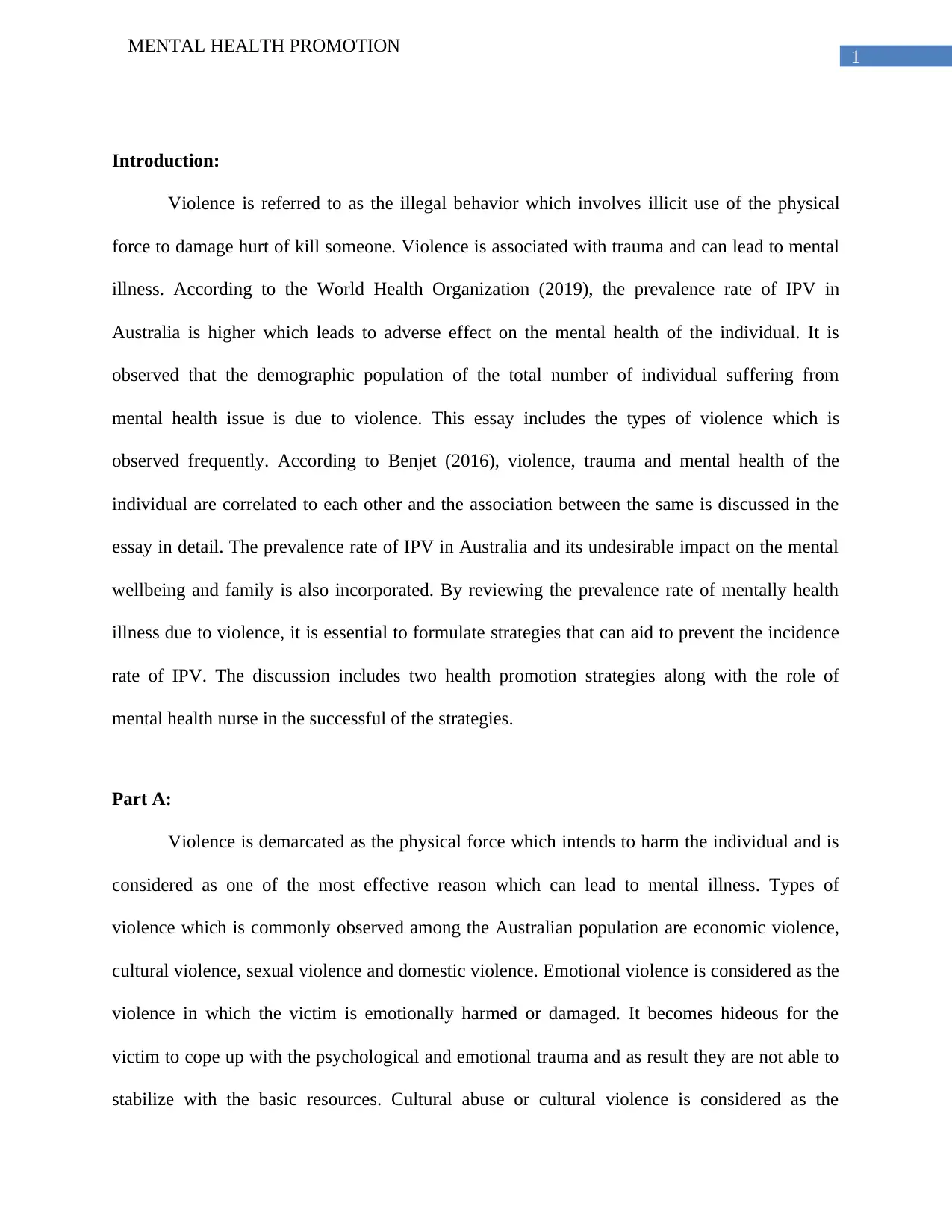
1
MENTAL HEALTH PROMOTION
Introduction:
Violence is referred to as the illegal behavior which involves illicit use of the physical
force to damage hurt of kill someone. Violence is associated with trauma and can lead to mental
illness. According to the World Health Organization (2019), the prevalence rate of IPV in
Australia is higher which leads to adverse effect on the mental health of the individual. It is
observed that the demographic population of the total number of individual suffering from
mental health issue is due to violence. This essay includes the types of violence which is
observed frequently. According to Benjet (2016), violence, trauma and mental health of the
individual are correlated to each other and the association between the same is discussed in the
essay in detail. The prevalence rate of IPV in Australia and its undesirable impact on the mental
wellbeing and family is also incorporated. By reviewing the prevalence rate of mentally health
illness due to violence, it is essential to formulate strategies that can aid to prevent the incidence
rate of IPV. The discussion includes two health promotion strategies along with the role of
mental health nurse in the successful of the strategies.
Part A:
Violence is demarcated as the physical force which intends to harm the individual and is
considered as one of the most effective reason which can lead to mental illness. Types of
violence which is commonly observed among the Australian population are economic violence,
cultural violence, sexual violence and domestic violence. Emotional violence is considered as the
violence in which the victim is emotionally harmed or damaged. It becomes hideous for the
victim to cope up with the psychological and emotional trauma and as result they are not able to
stabilize with the basic resources. Cultural abuse or cultural violence is considered as the
MENTAL HEALTH PROMOTION
Introduction:
Violence is referred to as the illegal behavior which involves illicit use of the physical
force to damage hurt of kill someone. Violence is associated with trauma and can lead to mental
illness. According to the World Health Organization (2019), the prevalence rate of IPV in
Australia is higher which leads to adverse effect on the mental health of the individual. It is
observed that the demographic population of the total number of individual suffering from
mental health issue is due to violence. This essay includes the types of violence which is
observed frequently. According to Benjet (2016), violence, trauma and mental health of the
individual are correlated to each other and the association between the same is discussed in the
essay in detail. The prevalence rate of IPV in Australia and its undesirable impact on the mental
wellbeing and family is also incorporated. By reviewing the prevalence rate of mentally health
illness due to violence, it is essential to formulate strategies that can aid to prevent the incidence
rate of IPV. The discussion includes two health promotion strategies along with the role of
mental health nurse in the successful of the strategies.
Part A:
Violence is demarcated as the physical force which intends to harm the individual and is
considered as one of the most effective reason which can lead to mental illness. Types of
violence which is commonly observed among the Australian population are economic violence,
cultural violence, sexual violence and domestic violence. Emotional violence is considered as the
violence in which the victim is emotionally harmed or damaged. It becomes hideous for the
victim to cope up with the psychological and emotional trauma and as result they are not able to
stabilize with the basic resources. Cultural abuse or cultural violence is considered as the

2
MENTAL HEALTH PROMOTION
violence based on culture. According to A. R. et al. (2018), Australian indigenous population is
considered as one of the most vulnerable population for the cultural violence. They are
discriminated based on their culture in school, colleges, work place and healthcare setting, which
can lead to mental illness (Wendt, 2016). According to Chmielowsk and Fuhr et al., (2017),
seven out of every ten indigenous individual have experienced discrimination and abuse at some
point of their life. Due to which the prevalence rate of mental illness among the indigenous
population is higher than that of any other population.
Violence occurs due to various reasons such as, due to lack of respect, minimal access to
power, family influence, low self-worth and experiencing abuse or neglect. According to the
Australian institute of Health and Welfare (2019), around 2.2 million of the total Australian
population has experienced physical and sexual abuse from their partners at some stage of their
life. Along with that about 3.6 million of the Australian populations have experienced emotional
abuse from their partners. Sexual abuse among the individual of age group less than 15 years is
also frequently observed in Australia. Rendering to the Wasarhaley et al. (2016), the intimate
partner violence is the most common type of domestic violence experienced contrary to women.
According to the Australian institute of Health and Welfare (2019), domestic violence can be
considered as the major concern that can lead to mental illness and among which the prevalence
rate of the intimate partner violence is highest and especially against the women. According to
the statistics by Australian institute of Health and Welfare, the rate of sexual assaults in men and
women is 1 in 5 and 1 in 20 respectively. The statistics also suggests the intimate partner can
cause more mental illness, death and disability than any other type of violence against women
and hence is also considered as the one of the significant risk factor for the mental illness for the
women of age group 25-44. In the year 2015 and 2016, it is observed that about 2800 women
MENTAL HEALTH PROMOTION
violence based on culture. According to A. R. et al. (2018), Australian indigenous population is
considered as one of the most vulnerable population for the cultural violence. They are
discriminated based on their culture in school, colleges, work place and healthcare setting, which
can lead to mental illness (Wendt, 2016). According to Chmielowsk and Fuhr et al., (2017),
seven out of every ten indigenous individual have experienced discrimination and abuse at some
point of their life. Due to which the prevalence rate of mental illness among the indigenous
population is higher than that of any other population.
Violence occurs due to various reasons such as, due to lack of respect, minimal access to
power, family influence, low self-worth and experiencing abuse or neglect. According to the
Australian institute of Health and Welfare (2019), around 2.2 million of the total Australian
population has experienced physical and sexual abuse from their partners at some stage of their
life. Along with that about 3.6 million of the Australian populations have experienced emotional
abuse from their partners. Sexual abuse among the individual of age group less than 15 years is
also frequently observed in Australia. Rendering to the Wasarhaley et al. (2016), the intimate
partner violence is the most common type of domestic violence experienced contrary to women.
According to the Australian institute of Health and Welfare (2019), domestic violence can be
considered as the major concern that can lead to mental illness and among which the prevalence
rate of the intimate partner violence is highest and especially against the women. According to
the statistics by Australian institute of Health and Welfare, the rate of sexual assaults in men and
women is 1 in 5 and 1 in 20 respectively. The statistics also suggests the intimate partner can
cause more mental illness, death and disability than any other type of violence against women
and hence is also considered as the one of the significant risk factor for the mental illness for the
women of age group 25-44. In the year 2015 and 2016, it is observed that about 2800 women
⊘ This is a preview!⊘
Do you want full access?
Subscribe today to unlock all pages.

Trusted by 1+ million students worldwide
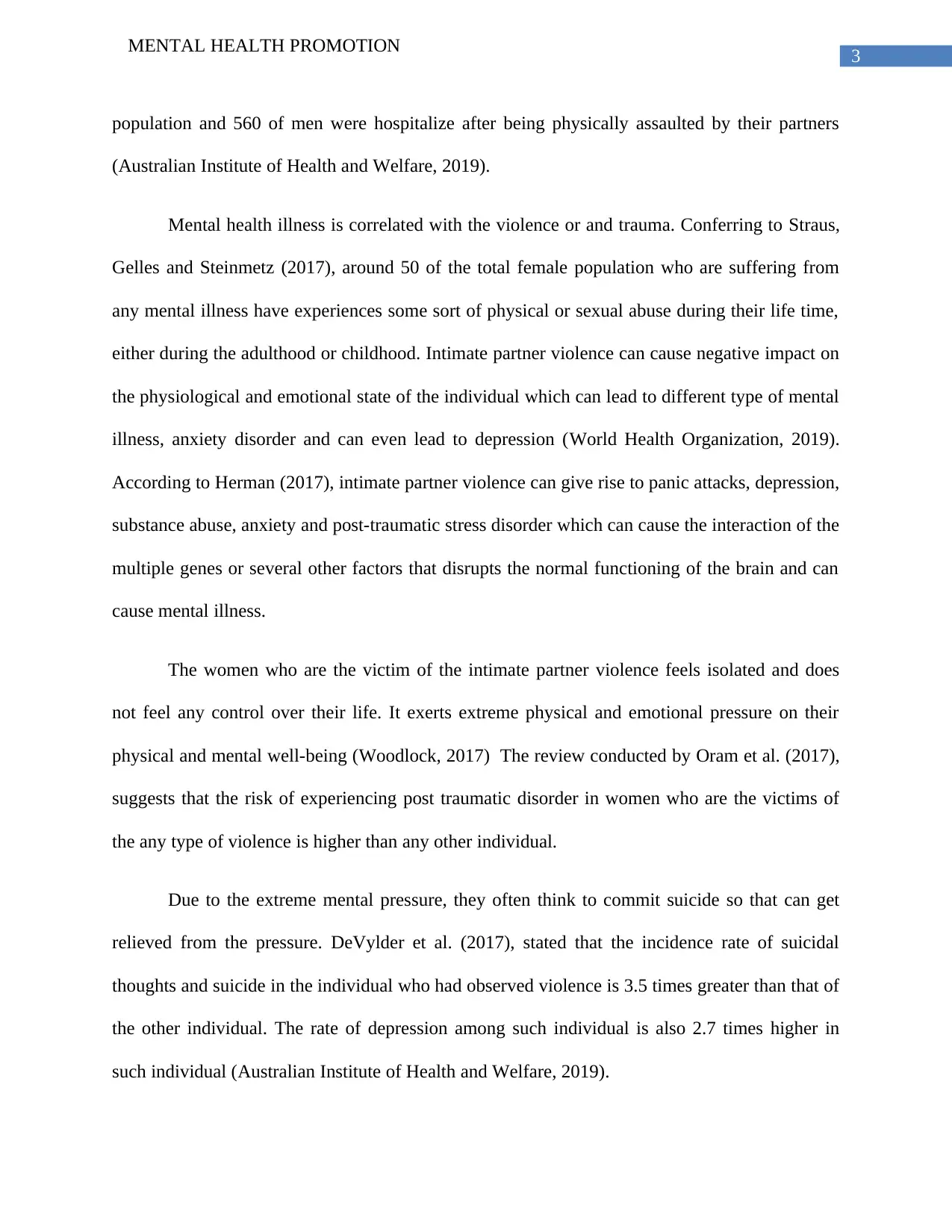
3
MENTAL HEALTH PROMOTION
population and 560 of men were hospitalize after being physically assaulted by their partners
(Australian Institute of Health and Welfare, 2019).
Mental health illness is correlated with the violence or and trauma. Conferring to Straus,
Gelles and Steinmetz (2017), around 50 of the total female population who are suffering from
any mental illness have experiences some sort of physical or sexual abuse during their life time,
either during the adulthood or childhood. Intimate partner violence can cause negative impact on
the physiological and emotional state of the individual which can lead to different type of mental
illness, anxiety disorder and can even lead to depression (World Health Organization, 2019).
According to Herman (2017), intimate partner violence can give rise to panic attacks, depression,
substance abuse, anxiety and post-traumatic stress disorder which can cause the interaction of the
multiple genes or several other factors that disrupts the normal functioning of the brain and can
cause mental illness.
The women who are the victim of the intimate partner violence feels isolated and does
not feel any control over their life. It exerts extreme physical and emotional pressure on their
physical and mental well-being (Woodlock, 2017) The review conducted by Oram et al. (2017),
suggests that the risk of experiencing post traumatic disorder in women who are the victims of
the any type of violence is higher than any other individual.
Due to the extreme mental pressure, they often think to commit suicide so that can get
relieved from the pressure. DeVylder et al. (2017), stated that the incidence rate of suicidal
thoughts and suicide in the individual who had observed violence is 3.5 times greater than that of
the other individual. The rate of depression among such individual is also 2.7 times higher in
such individual (Australian Institute of Health and Welfare, 2019).
MENTAL HEALTH PROMOTION
population and 560 of men were hospitalize after being physically assaulted by their partners
(Australian Institute of Health and Welfare, 2019).
Mental health illness is correlated with the violence or and trauma. Conferring to Straus,
Gelles and Steinmetz (2017), around 50 of the total female population who are suffering from
any mental illness have experiences some sort of physical or sexual abuse during their life time,
either during the adulthood or childhood. Intimate partner violence can cause negative impact on
the physiological and emotional state of the individual which can lead to different type of mental
illness, anxiety disorder and can even lead to depression (World Health Organization, 2019).
According to Herman (2017), intimate partner violence can give rise to panic attacks, depression,
substance abuse, anxiety and post-traumatic stress disorder which can cause the interaction of the
multiple genes or several other factors that disrupts the normal functioning of the brain and can
cause mental illness.
The women who are the victim of the intimate partner violence feels isolated and does
not feel any control over their life. It exerts extreme physical and emotional pressure on their
physical and mental well-being (Woodlock, 2017) The review conducted by Oram et al. (2017),
suggests that the risk of experiencing post traumatic disorder in women who are the victims of
the any type of violence is higher than any other individual.
Due to the extreme mental pressure, they often think to commit suicide so that can get
relieved from the pressure. DeVylder et al. (2017), stated that the incidence rate of suicidal
thoughts and suicide in the individual who had observed violence is 3.5 times greater than that of
the other individual. The rate of depression among such individual is also 2.7 times higher in
such individual (Australian Institute of Health and Welfare, 2019).
Paraphrase This Document
Need a fresh take? Get an instant paraphrase of this document with our AI Paraphraser
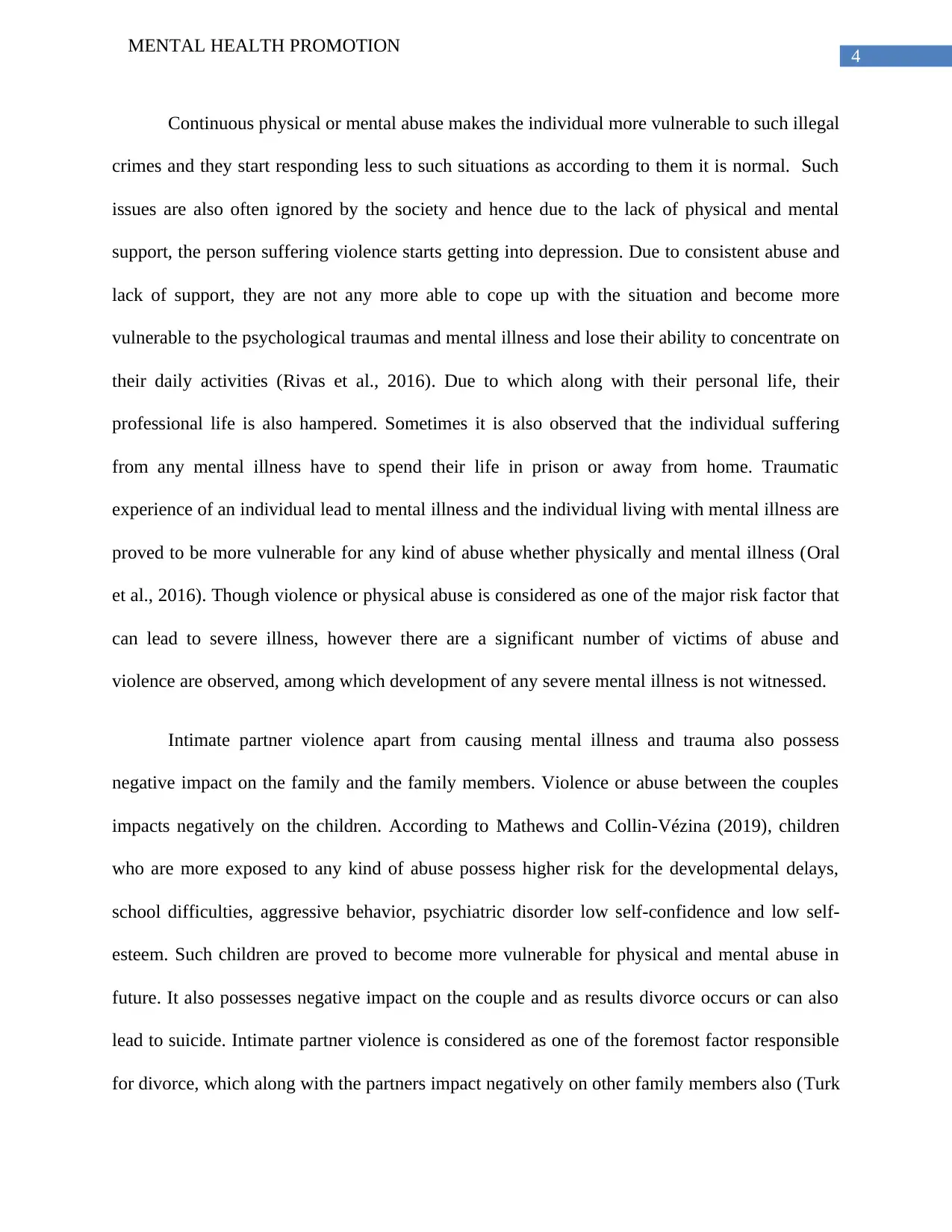
4
MENTAL HEALTH PROMOTION
Continuous physical or mental abuse makes the individual more vulnerable to such illegal
crimes and they start responding less to such situations as according to them it is normal. Such
issues are also often ignored by the society and hence due to the lack of physical and mental
support, the person suffering violence starts getting into depression. Due to consistent abuse and
lack of support, they are not any more able to cope up with the situation and become more
vulnerable to the psychological traumas and mental illness and lose their ability to concentrate on
their daily activities (Rivas et al., 2016). Due to which along with their personal life, their
professional life is also hampered. Sometimes it is also observed that the individual suffering
from any mental illness have to spend their life in prison or away from home. Traumatic
experience of an individual lead to mental illness and the individual living with mental illness are
proved to be more vulnerable for any kind of abuse whether physically and mental illness (Oral
et al., 2016). Though violence or physical abuse is considered as one of the major risk factor that
can lead to severe illness, however there are a significant number of victims of abuse and
violence are observed, among which development of any severe mental illness is not witnessed.
Intimate partner violence apart from causing mental illness and trauma also possess
negative impact on the family and the family members. Violence or abuse between the couples
impacts negatively on the children. According to Mathews and Collin-Vézina (2019), children
who are more exposed to any kind of abuse possess higher risk for the developmental delays,
school difficulties, aggressive behavior, psychiatric disorder low self-confidence and low self-
esteem. Such children are proved to become more vulnerable for physical and mental abuse in
future. It also possesses negative impact on the couple and as results divorce occurs or can also
lead to suicide. Intimate partner violence is considered as one of the foremost factor responsible
for divorce, which along with the partners impact negatively on other family members also (Turk
MENTAL HEALTH PROMOTION
Continuous physical or mental abuse makes the individual more vulnerable to such illegal
crimes and they start responding less to such situations as according to them it is normal. Such
issues are also often ignored by the society and hence due to the lack of physical and mental
support, the person suffering violence starts getting into depression. Due to consistent abuse and
lack of support, they are not any more able to cope up with the situation and become more
vulnerable to the psychological traumas and mental illness and lose their ability to concentrate on
their daily activities (Rivas et al., 2016). Due to which along with their personal life, their
professional life is also hampered. Sometimes it is also observed that the individual suffering
from any mental illness have to spend their life in prison or away from home. Traumatic
experience of an individual lead to mental illness and the individual living with mental illness are
proved to be more vulnerable for any kind of abuse whether physically and mental illness (Oral
et al., 2016). Though violence or physical abuse is considered as one of the major risk factor that
can lead to severe illness, however there are a significant number of victims of abuse and
violence are observed, among which development of any severe mental illness is not witnessed.
Intimate partner violence apart from causing mental illness and trauma also possess
negative impact on the family and the family members. Violence or abuse between the couples
impacts negatively on the children. According to Mathews and Collin-Vézina (2019), children
who are more exposed to any kind of abuse possess higher risk for the developmental delays,
school difficulties, aggressive behavior, psychiatric disorder low self-confidence and low self-
esteem. Such children are proved to become more vulnerable for physical and mental abuse in
future. It also possesses negative impact on the couple and as results divorce occurs or can also
lead to suicide. Intimate partner violence is considered as one of the foremost factor responsible
for divorce, which along with the partners impact negatively on other family members also (Turk
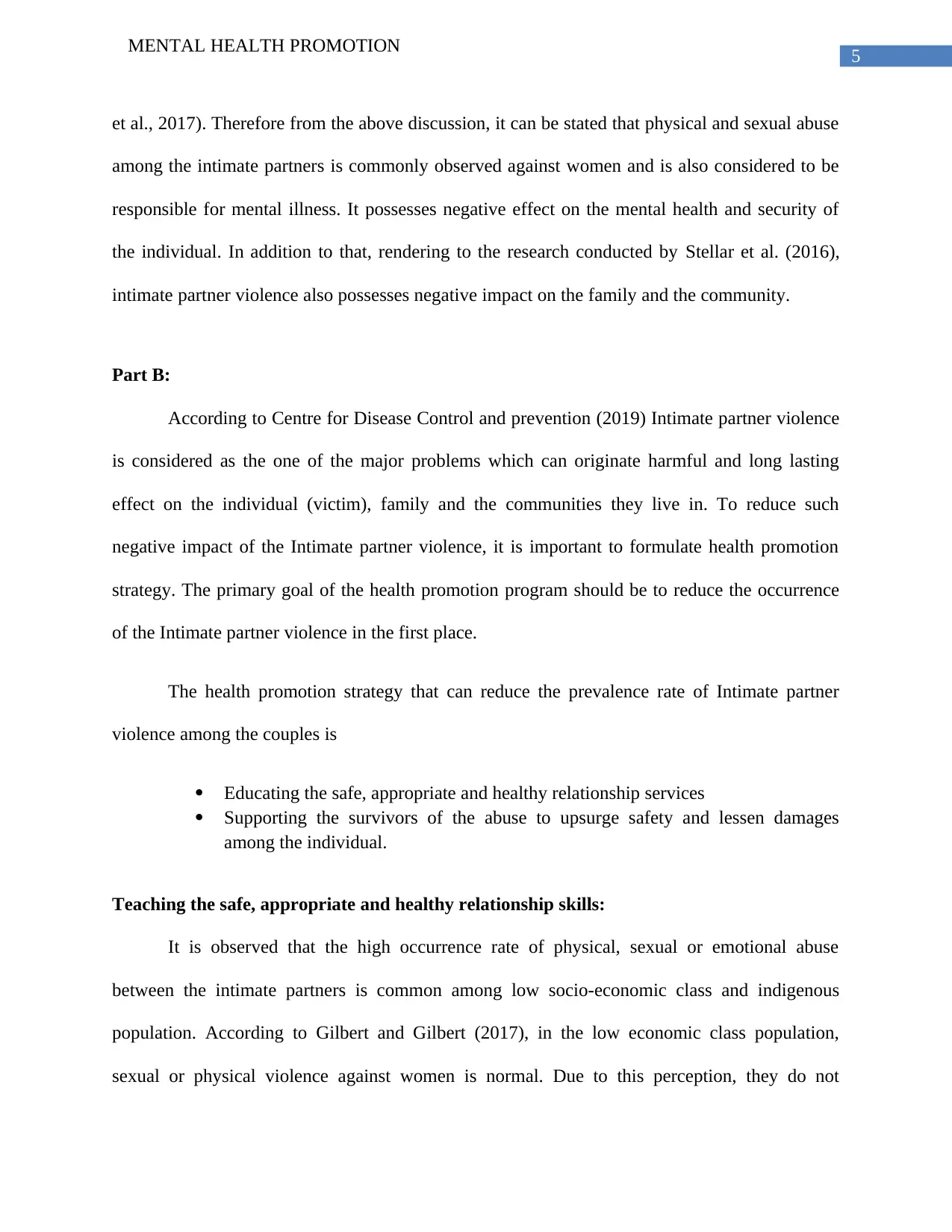
5
MENTAL HEALTH PROMOTION
et al., 2017). Therefore from the above discussion, it can be stated that physical and sexual abuse
among the intimate partners is commonly observed against women and is also considered to be
responsible for mental illness. It possesses negative effect on the mental health and security of
the individual. In addition to that, rendering to the research conducted by Stellar et al. (2016),
intimate partner violence also possesses negative impact on the family and the community.
Part B:
According to Centre for Disease Control and prevention (2019) Intimate partner violence
is considered as the one of the major problems which can originate harmful and long lasting
effect on the individual (victim), family and the communities they live in. To reduce such
negative impact of the Intimate partner violence, it is important to formulate health promotion
strategy. The primary goal of the health promotion program should be to reduce the occurrence
of the Intimate partner violence in the first place.
The health promotion strategy that can reduce the prevalence rate of Intimate partner
violence among the couples is
Educating the safe, appropriate and healthy relationship services
Supporting the survivors of the abuse to upsurge safety and lessen damages
among the individual.
Teaching the safe, appropriate and healthy relationship skills:
It is observed that the high occurrence rate of physical, sexual or emotional abuse
between the intimate partners is common among low socio-economic class and indigenous
population. According to Gilbert and Gilbert (2017), in the low economic class population,
sexual or physical violence against women is normal. Due to this perception, they do not
MENTAL HEALTH PROMOTION
et al., 2017). Therefore from the above discussion, it can be stated that physical and sexual abuse
among the intimate partners is commonly observed against women and is also considered to be
responsible for mental illness. It possesses negative effect on the mental health and security of
the individual. In addition to that, rendering to the research conducted by Stellar et al. (2016),
intimate partner violence also possesses negative impact on the family and the community.
Part B:
According to Centre for Disease Control and prevention (2019) Intimate partner violence
is considered as the one of the major problems which can originate harmful and long lasting
effect on the individual (victim), family and the communities they live in. To reduce such
negative impact of the Intimate partner violence, it is important to formulate health promotion
strategy. The primary goal of the health promotion program should be to reduce the occurrence
of the Intimate partner violence in the first place.
The health promotion strategy that can reduce the prevalence rate of Intimate partner
violence among the couples is
Educating the safe, appropriate and healthy relationship services
Supporting the survivors of the abuse to upsurge safety and lessen damages
among the individual.
Teaching the safe, appropriate and healthy relationship skills:
It is observed that the high occurrence rate of physical, sexual or emotional abuse
between the intimate partners is common among low socio-economic class and indigenous
population. According to Gilbert and Gilbert (2017), in the low economic class population,
sexual or physical violence against women is normal. Due to this perception, they do not
⊘ This is a preview!⊘
Do you want full access?
Subscribe today to unlock all pages.

Trusted by 1+ million students worldwide

6
MENTAL HEALTH PROMOTION
consider intimate partner violence as a crime and do not report against it. Therefore, it is
important to educate such individual that physical, sexual or emotional violence is a crime and
should not be practiced within the family members (Centre for Disease Control and prevention,
2019).
There are different approaches that can be used to teach safe and healthy relationship skill
among couples which aid to decrease the incidence rate of the intimate partner violence. The
youth are more vulnerable to such crimes and hence should be involved in Social-emotional
learning program. With the aid of program, expectation of the youth for the caring, respectful
and non-violent relationships are enhanced (Centre for Disease Control and prevention, 2019). In
order to achieve such relationships with the partner they are educated with different types of skill
which include respect, empathy, healthy communication and the conflict resolution skills. Apart
from these, they are also involved in the Healthy relationship programs for the intimate couples
where they are educated about the strategies that can help them to maintain a healthy
relationship.
According to a research conducted by Lyons et al. (2016), teaching the couples about the
strategy to enhance safe and healthy relationship is considered to be one of the most effective
methods to reduce the occurrence rate of the intimate partner violence. It aids the couples to
increase the applicability of the healthy relationship skill. Along with that it also aims to reduce
the responsibility and victimization of sexual, physical emotional intimate partner violence and
stalking. It also reduces the risk of substance use, weapon carrying, bullying, peer violence and
other high-risk sexual and physical behavior (Centre for Disease Control and prevention, 2019).
MENTAL HEALTH PROMOTION
consider intimate partner violence as a crime and do not report against it. Therefore, it is
important to educate such individual that physical, sexual or emotional violence is a crime and
should not be practiced within the family members (Centre for Disease Control and prevention,
2019).
There are different approaches that can be used to teach safe and healthy relationship skill
among couples which aid to decrease the incidence rate of the intimate partner violence. The
youth are more vulnerable to such crimes and hence should be involved in Social-emotional
learning program. With the aid of program, expectation of the youth for the caring, respectful
and non-violent relationships are enhanced (Centre for Disease Control and prevention, 2019). In
order to achieve such relationships with the partner they are educated with different types of skill
which include respect, empathy, healthy communication and the conflict resolution skills. Apart
from these, they are also involved in the Healthy relationship programs for the intimate couples
where they are educated about the strategies that can help them to maintain a healthy
relationship.
According to a research conducted by Lyons et al. (2016), teaching the couples about the
strategy to enhance safe and healthy relationship is considered to be one of the most effective
methods to reduce the occurrence rate of the intimate partner violence. It aids the couples to
increase the applicability of the healthy relationship skill. Along with that it also aims to reduce
the responsibility and victimization of sexual, physical emotional intimate partner violence and
stalking. It also reduces the risk of substance use, weapon carrying, bullying, peer violence and
other high-risk sexual and physical behavior (Centre for Disease Control and prevention, 2019).
Paraphrase This Document
Need a fresh take? Get an instant paraphrase of this document with our AI Paraphraser

7
MENTAL HEALTH PROMOTION
Supporting the intimate partner violence survivors:
Rendering to the findings of the research conducted by Sijbrandij et al. (2016), the
survivor of the intimate partner violence have higher risks of getting effected by any physical
and mental illness. They experience a long-term undesirable health outcome which includes HIV
and other sexually communicated infection, gastrointestinal, chronic pain and neurological
disorders, depression, substance abuse, and anxiety, PTSD, chronic diseases, eating and sleep
disorders, suicide and higher rates of homicide. The approach which can lessen the incidence
rate of the intimate partner violence is by offering Victim-centered services, First responder and
civil legal protections, Housing programs, patient centered approaches and appropriate treatment
plan. With the aid of the discussed approaches, physical safety of the patient is increased and
along with that through the Housing programs, housing stability of the patient is also enhanced
(Centre for Disease Control and prevention, 2019). It also helps to diminish the incidence rate of
intimate partner violence. It helps the patient to cope with the situation by encouraging positive
behaviors. As this strategy also involves patient centered care, therefore it also helps the patient
in reducing the long term and short term negative health consequences of the intimate partner
violence. By doing this the patient who are already suffering from mental illness or are at the
high risk of getting effected gets proper treatment against the physical and mental illness such as,
any physical injury or illness, post traumatic severe disorder, depression, HIV and anxiety
(Centre for Disease Control and prevention, 2019).
Role of nurse:
Nursing is the profession which intends to distribute quality and safe care to the patients
who are suffering from several mental illness or physical illness. The primary purpose of the
nurse is to deliver care to the patient based on their requirements and preferences (Al‐Natour,
MENTAL HEALTH PROMOTION
Supporting the intimate partner violence survivors:
Rendering to the findings of the research conducted by Sijbrandij et al. (2016), the
survivor of the intimate partner violence have higher risks of getting effected by any physical
and mental illness. They experience a long-term undesirable health outcome which includes HIV
and other sexually communicated infection, gastrointestinal, chronic pain and neurological
disorders, depression, substance abuse, and anxiety, PTSD, chronic diseases, eating and sleep
disorders, suicide and higher rates of homicide. The approach which can lessen the incidence
rate of the intimate partner violence is by offering Victim-centered services, First responder and
civil legal protections, Housing programs, patient centered approaches and appropriate treatment
plan. With the aid of the discussed approaches, physical safety of the patient is increased and
along with that through the Housing programs, housing stability of the patient is also enhanced
(Centre for Disease Control and prevention, 2019). It also helps to diminish the incidence rate of
intimate partner violence. It helps the patient to cope with the situation by encouraging positive
behaviors. As this strategy also involves patient centered care, therefore it also helps the patient
in reducing the long term and short term negative health consequences of the intimate partner
violence. By doing this the patient who are already suffering from mental illness or are at the
high risk of getting effected gets proper treatment against the physical and mental illness such as,
any physical injury or illness, post traumatic severe disorder, depression, HIV and anxiety
(Centre for Disease Control and prevention, 2019).
Role of nurse:
Nursing is the profession which intends to distribute quality and safe care to the patients
who are suffering from several mental illness or physical illness. The primary purpose of the
nurse is to deliver care to the patient based on their requirements and preferences (Al‐Natour,
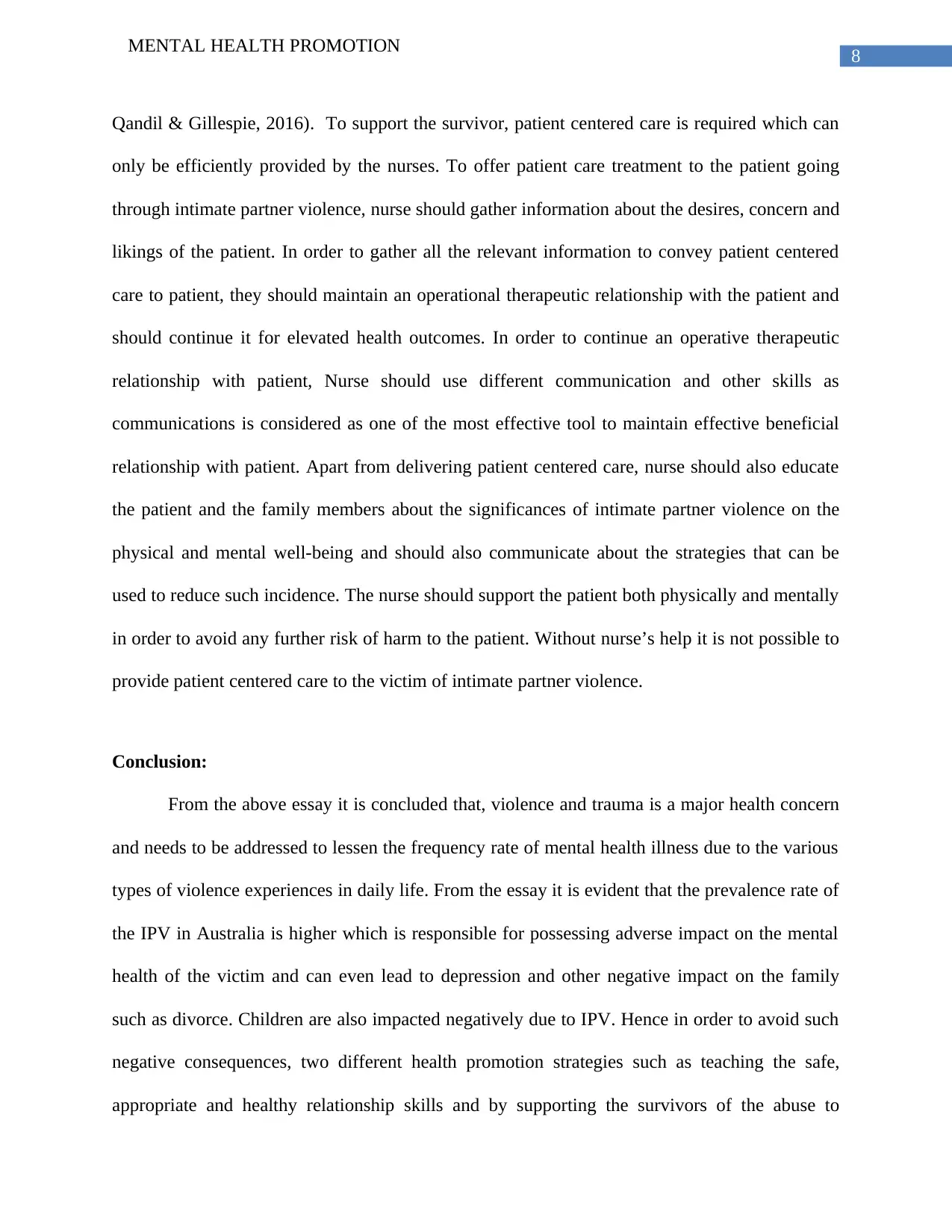
8
MENTAL HEALTH PROMOTION
Qandil & Gillespie, 2016). To support the survivor, patient centered care is required which can
only be efficiently provided by the nurses. To offer patient care treatment to the patient going
through intimate partner violence, nurse should gather information about the desires, concern and
likings of the patient. In order to gather all the relevant information to convey patient centered
care to patient, they should maintain an operational therapeutic relationship with the patient and
should continue it for elevated health outcomes. In order to continue an operative therapeutic
relationship with patient, Nurse should use different communication and other skills as
communications is considered as one of the most effective tool to maintain effective beneficial
relationship with patient. Apart from delivering patient centered care, nurse should also educate
the patient and the family members about the significances of intimate partner violence on the
physical and mental well-being and should also communicate about the strategies that can be
used to reduce such incidence. The nurse should support the patient both physically and mentally
in order to avoid any further risk of harm to the patient. Without nurse’s help it is not possible to
provide patient centered care to the victim of intimate partner violence.
Conclusion:
From the above essay it is concluded that, violence and trauma is a major health concern
and needs to be addressed to lessen the frequency rate of mental health illness due to the various
types of violence experiences in daily life. From the essay it is evident that the prevalence rate of
the IPV in Australia is higher which is responsible for possessing adverse impact on the mental
health of the victim and can even lead to depression and other negative impact on the family
such as divorce. Children are also impacted negatively due to IPV. Hence in order to avoid such
negative consequences, two different health promotion strategies such as teaching the safe,
appropriate and healthy relationship skills and by supporting the survivors of the abuse to
MENTAL HEALTH PROMOTION
Qandil & Gillespie, 2016). To support the survivor, patient centered care is required which can
only be efficiently provided by the nurses. To offer patient care treatment to the patient going
through intimate partner violence, nurse should gather information about the desires, concern and
likings of the patient. In order to gather all the relevant information to convey patient centered
care to patient, they should maintain an operational therapeutic relationship with the patient and
should continue it for elevated health outcomes. In order to continue an operative therapeutic
relationship with patient, Nurse should use different communication and other skills as
communications is considered as one of the most effective tool to maintain effective beneficial
relationship with patient. Apart from delivering patient centered care, nurse should also educate
the patient and the family members about the significances of intimate partner violence on the
physical and mental well-being and should also communicate about the strategies that can be
used to reduce such incidence. The nurse should support the patient both physically and mentally
in order to avoid any further risk of harm to the patient. Without nurse’s help it is not possible to
provide patient centered care to the victim of intimate partner violence.
Conclusion:
From the above essay it is concluded that, violence and trauma is a major health concern
and needs to be addressed to lessen the frequency rate of mental health illness due to the various
types of violence experiences in daily life. From the essay it is evident that the prevalence rate of
the IPV in Australia is higher which is responsible for possessing adverse impact on the mental
health of the victim and can even lead to depression and other negative impact on the family
such as divorce. Children are also impacted negatively due to IPV. Hence in order to avoid such
negative consequences, two different health promotion strategies such as teaching the safe,
appropriate and healthy relationship skills and by supporting the survivors of the abuse to
⊘ This is a preview!⊘
Do you want full access?
Subscribe today to unlock all pages.

Trusted by 1+ million students worldwide

9
MENTAL HEALTH PROMOTION
upsurge safety and diminish harms among the individual is suggested in the essay. For the
successful implementation of the suggested health promotion strategy, it is essential for the nurse
create awareness about the negative effect of IPV on the mental wellbeing to the vulnerable
populations.
MENTAL HEALTH PROMOTION
upsurge safety and diminish harms among the individual is suggested in the essay. For the
successful implementation of the suggested health promotion strategy, it is essential for the nurse
create awareness about the negative effect of IPV on the mental wellbeing to the vulnerable
populations.
Paraphrase This Document
Need a fresh take? Get an instant paraphrase of this document with our AI Paraphraser

10
MENTAL HEALTH PROMOTION
Reference:
Al‐Natour, A., Qandil, A., & Gillespie, G. L. (2016). Nurses' roles in screening for intimate
partner violence: a phenomenological study. International nursing review, 63(3), 422-
428.
Australian Institute of Health and Welfare. (2019). Family, domestic and sexual violence in
Australia, 2018, Summary - Australian Institute of Health and Welfare. Retrieved 15
September 2019, from https://www.aihw.gov.au/reports/domestic-violence/family-
domestic-sexual-violence-in-australia-2018/contents/summary
Benjet, C., Bromet, E., Karam, E. G., Kessler, R. C., McLaughlin, K. A., Ruscio, A. M., ... &
Alonso, J. (2016). The epidemiology of traumatic event exposure worldwide: results from
the World Mental Health Survey Consortium. Psychological medicine, 46(2), 327-343.
Centre for Disease Control and prevention. (2019). Retrieved 15 September 2019, from
https://www.cdc.gov/violenceprevention/pdf/ipv-technicalpackages.pdf#IPV
%20Technical%20Package.indd%3A.14085%3A76
Chmielowska, M., & Fuhr, D. C. (2017). Intimate partner violence and mental ill health among
global populations of indigenous women: a systematic review. Social psychiatry and
psychiatric epidemiology, 52(6), 689-704.
DeVylder, J. E., Frey, J. J., Cogburn, C. D., Wilcox, H. C., Sharpe, T. L., Oh, H. Y., ... & Link,
B. G. (2017). Elevated prevalence of suicide attempts among victims of police violence
in the USA. Journal of urban health, 94(5), 629-636.
MENTAL HEALTH PROMOTION
Reference:
Al‐Natour, A., Qandil, A., & Gillespie, G. L. (2016). Nurses' roles in screening for intimate
partner violence: a phenomenological study. International nursing review, 63(3), 422-
428.
Australian Institute of Health and Welfare. (2019). Family, domestic and sexual violence in
Australia, 2018, Summary - Australian Institute of Health and Welfare. Retrieved 15
September 2019, from https://www.aihw.gov.au/reports/domestic-violence/family-
domestic-sexual-violence-in-australia-2018/contents/summary
Benjet, C., Bromet, E., Karam, E. G., Kessler, R. C., McLaughlin, K. A., Ruscio, A. M., ... &
Alonso, J. (2016). The epidemiology of traumatic event exposure worldwide: results from
the World Mental Health Survey Consortium. Psychological medicine, 46(2), 327-343.
Centre for Disease Control and prevention. (2019). Retrieved 15 September 2019, from
https://www.cdc.gov/violenceprevention/pdf/ipv-technicalpackages.pdf#IPV
%20Technical%20Package.indd%3A.14085%3A76
Chmielowska, M., & Fuhr, D. C. (2017). Intimate partner violence and mental ill health among
global populations of indigenous women: a systematic review. Social psychiatry and
psychiatric epidemiology, 52(6), 689-704.
DeVylder, J. E., Frey, J. J., Cogburn, C. D., Wilcox, H. C., Sharpe, T. L., Oh, H. Y., ... & Link,
B. G. (2017). Elevated prevalence of suicide attempts among victims of police violence
in the USA. Journal of urban health, 94(5), 629-636.
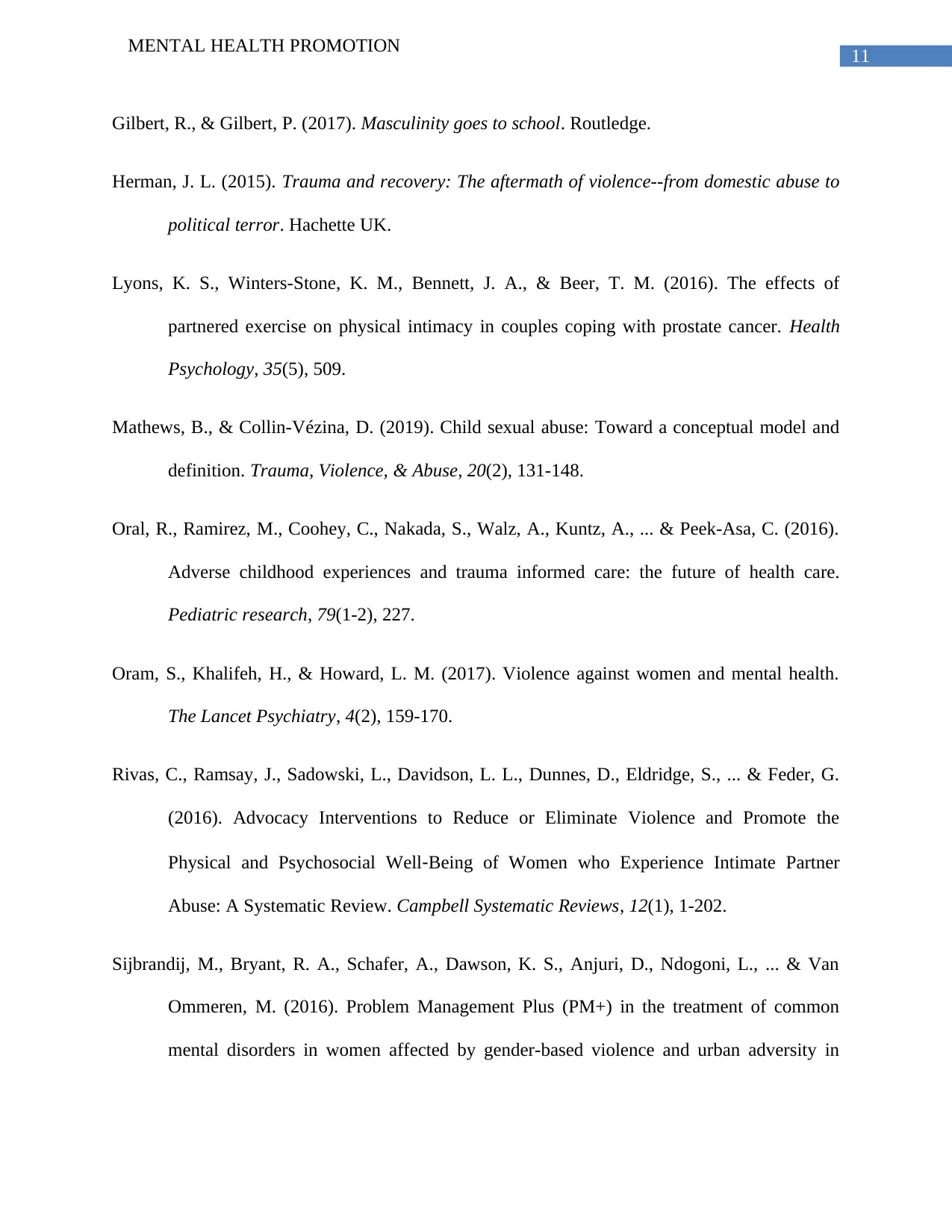
11
MENTAL HEALTH PROMOTION
Gilbert, R., & Gilbert, P. (2017). Masculinity goes to school. Routledge.
Herman, J. L. (2015). Trauma and recovery: The aftermath of violence--from domestic abuse to
political terror. Hachette UK.
Lyons, K. S., Winters-Stone, K. M., Bennett, J. A., & Beer, T. M. (2016). The effects of
partnered exercise on physical intimacy in couples coping with prostate cancer. Health
Psychology, 35(5), 509.
Mathews, B., & Collin-Vézina, D. (2019). Child sexual abuse: Toward a conceptual model and
definition. Trauma, Violence, & Abuse, 20(2), 131-148.
Oral, R., Ramirez, M., Coohey, C., Nakada, S., Walz, A., Kuntz, A., ... & Peek-Asa, C. (2016).
Adverse childhood experiences and trauma informed care: the future of health care.
Pediatric research, 79(1-2), 227.
Oram, S., Khalifeh, H., & Howard, L. M. (2017). Violence against women and mental health.
The Lancet Psychiatry, 4(2), 159-170.
Rivas, C., Ramsay, J., Sadowski, L., Davidson, L. L., Dunnes, D., Eldridge, S., ... & Feder, G.
(2016). Advocacy Interventions to Reduce or Eliminate Violence and Promote the
Physical and Psychosocial Well‐Being of Women who Experience Intimate Partner
Abuse: A Systematic Review. Campbell Systematic Reviews, 12(1), 1-202.
Sijbrandij, M., Bryant, R. A., Schafer, A., Dawson, K. S., Anjuri, D., Ndogoni, L., ... & Van
Ommeren, M. (2016). Problem Management Plus (PM+) in the treatment of common
mental disorders in women affected by gender-based violence and urban adversity in
MENTAL HEALTH PROMOTION
Gilbert, R., & Gilbert, P. (2017). Masculinity goes to school. Routledge.
Herman, J. L. (2015). Trauma and recovery: The aftermath of violence--from domestic abuse to
political terror. Hachette UK.
Lyons, K. S., Winters-Stone, K. M., Bennett, J. A., & Beer, T. M. (2016). The effects of
partnered exercise on physical intimacy in couples coping with prostate cancer. Health
Psychology, 35(5), 509.
Mathews, B., & Collin-Vézina, D. (2019). Child sexual abuse: Toward a conceptual model and
definition. Trauma, Violence, & Abuse, 20(2), 131-148.
Oral, R., Ramirez, M., Coohey, C., Nakada, S., Walz, A., Kuntz, A., ... & Peek-Asa, C. (2016).
Adverse childhood experiences and trauma informed care: the future of health care.
Pediatric research, 79(1-2), 227.
Oram, S., Khalifeh, H., & Howard, L. M. (2017). Violence against women and mental health.
The Lancet Psychiatry, 4(2), 159-170.
Rivas, C., Ramsay, J., Sadowski, L., Davidson, L. L., Dunnes, D., Eldridge, S., ... & Feder, G.
(2016). Advocacy Interventions to Reduce or Eliminate Violence and Promote the
Physical and Psychosocial Well‐Being of Women who Experience Intimate Partner
Abuse: A Systematic Review. Campbell Systematic Reviews, 12(1), 1-202.
Sijbrandij, M., Bryant, R. A., Schafer, A., Dawson, K. S., Anjuri, D., Ndogoni, L., ... & Van
Ommeren, M. (2016). Problem Management Plus (PM+) in the treatment of common
mental disorders in women affected by gender-based violence and urban adversity in
⊘ This is a preview!⊘
Do you want full access?
Subscribe today to unlock all pages.

Trusted by 1+ million students worldwide
1 out of 14
Related Documents
Your All-in-One AI-Powered Toolkit for Academic Success.
+13062052269
info@desklib.com
Available 24*7 on WhatsApp / Email
![[object Object]](/_next/static/media/star-bottom.7253800d.svg)
Unlock your academic potential
Copyright © 2020–2025 A2Z Services. All Rights Reserved. Developed and managed by ZUCOL.




